❑Understanding the List options:
•On any General Maintenance Form, you may Click the List Icon to display a tabular spreadsheet style Data View, which will (usually) expand the Navigation Menu to include the Export and Print Icons and show the Data Grid.
✓When the List Icon is selected, a Tabular View (i.e., Data Grid) of all of the Maintenance Form's records is displayed
![]()
Billing Cycles Form with List View activated showing the Export and Print Icons
✓Click the List Icon again to Close the Tabular View (i.e., Data Grid) and return to the Record Editing View.
•Choosing the Columns to be Viewed:
✓Some columns may contain expanded comments or other information (e.g., the details of Action Steps of an Action Plan) which may make the List View's display difficult to use.
Ø In the List View, you may Click the Asterisk (usually available) at the left of the row of Header Names to display a Drop-Down Check List of each column's Headed Name.
▪Check any Header Name to be included in the List View (by default, All Header Names will be Checked)
▪Remove the Check for any Header Name (see illustration below) that is to be removed from the List View.
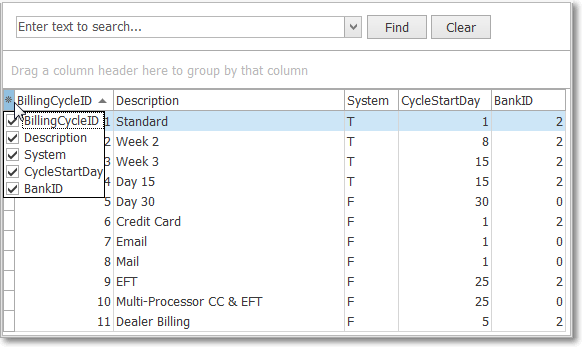
•Locating the desired record:

✓Find - Enter text to search for a specific record, then Click the Find option.
✓Clear - To remove the text to search for entry, Click the Clear option
•Setting the Order in which the Grid Data is Listed
✓The sorted order of the List, by default, is based on the first column in the Grid Data list - ordered from lowest to highest (a-z or 1 - 9).
✓Thereafter, the column that determines the sorted order in which the Grid Data is listed, may be easily changed, as needed.
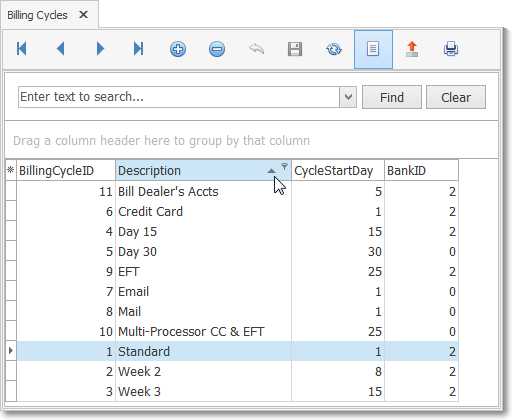
▪Click another column's Header Name to change the sorted order to that column, with the sorted order automatically set from lowest to highest (a-z or 1 - 9).
▪To change this newly selected column's sorted order from highest to lowest, Click that column's Header Name again.
▪An Arrow next to the Header Name indicates the column that is determining the sorted order of the Grid Data.
o~ indicates lowest to highest (a-z or 1 - 9)
o€ indicates highest to lowest (z-a or 9-1).
➢Important Note: This selected sorting order (which becomes the new default sorting order) will also determine (when the User is not in the List View mode) the order in which those records are displayed as those Record Movement options are used on the Main Form's Ribbon Menu.
•Grouping the Grid Data - The Grid Data View may be separated into Groups based on a selected column's Header Name.
✓Click the Header Name (i.e., "System" was selected in the illustration below) and Drag that Header Name to the "Drag a column header here to group by that column" message area at the top of the Grid.
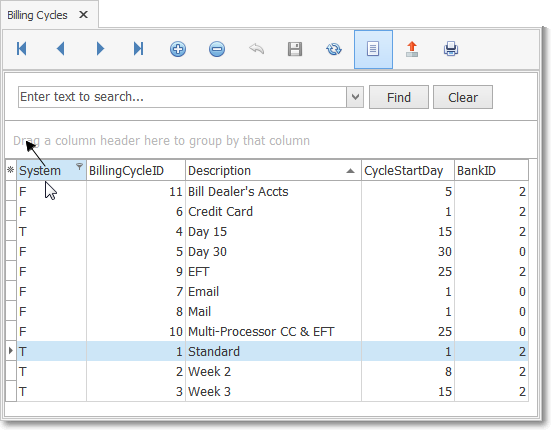
✓The Grid Data will be sorted by that Header Name
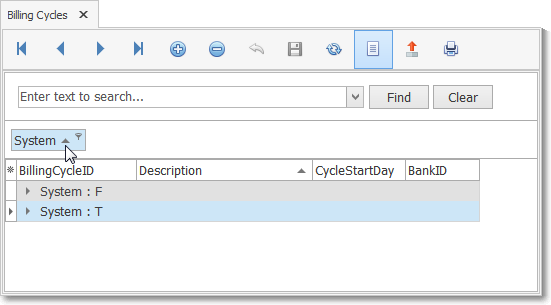
✓Only each unique example of that Header Name will be listed, the contents (Grid Data Detail) of each Group will be concealed.
•Viewing each Group's Grid Data Detail - Once a Grid has been sorted into Groups, each Group's Grid Data Detail may be displayed by Clicking the special Arrow to the left of the Group Name.

✓The mouse pointer in the illustration above shows the small Arrow to the left of the "System:F" Group.
▪In the illustration above, the Group System:F has ordered the Description column from lowest to highest.
•Sorting each Group's Grid Data Detail
✓Once a Group's Grid Data Detail has been displayed, the sorted order of that Grid Data Detail may be reset by the User by Clicking the Header Name representing the desired sort order.
▪To change this sorted order of the Grid Data Detail from highest to lowest, back to lowest to highest, Click that column's Header Name again.
•Specifying the Group(s) that are to be displayed, and/or the specific Grid Data Detail Items that are displayed, using the Special Selection Icon - ![]()
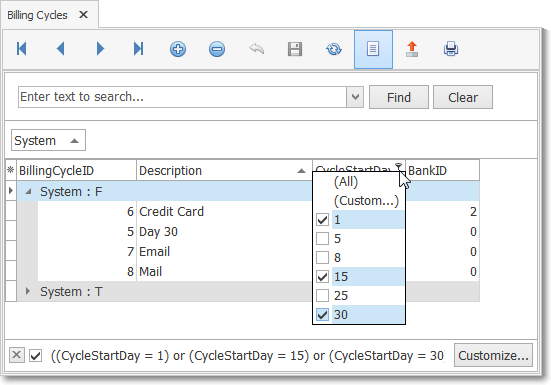
✓Click the Special Selection Icon associated with that column's Header Name (or Group's Name) to display its associated Drop-Down Selection List
▪The List will contain the available options for that specific column's Header Name (or Group's Name)
✓In the example above, the CycleStartDay column contains the list of available items and a Check Box is positioned next to each item
▪Check each item that is to be included.
▪The un-checked items will disappear.
✓To cancel the Grouping, just Drag & Drop the selected Header Name back to the Header itself.
▪If this data grid is closed when Grouping is still in effect, once reopened, the previously established Grouping will still be in effect.
❑Creating a Custom Filter for the List, a Group, and/or Grid Data Detail
•Sometimes, because of a great many items in the List, the User may need a more refined method to Chose which Data will be included in the Maintenance Form's Grid.
✓To accommodate this need, the Special Selection Icon's Drop-Down Selection List - described above - also provides a "(Custom...)" option.
✓This Custom Filter option is available whenever the Special Selection Icon is displayed - which is anytime the mouse pointer is positioned over a Header Name in the Grid - by Clicking that Icon and then Choosing the (Custom...) option.
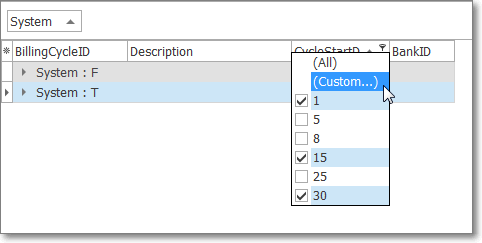
•When the Custom Filter option is selected, the Custom Filter dialog is displayed.
✓The first filtering choice is "Show rows where" with the selected Header Name shown.
✓If a previously defined is Special Selection has been entered (as was shown in the illustration above, it will be entered automatically as shown below.
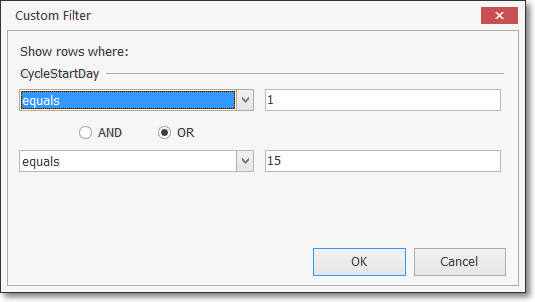
•To (re-)define this initial filtering criteria, the User is requested to quantify how the selected column's data should compare to a value (or a different field) in one or two situations (e.g., one comparison, an OR comparison, or an AND comparison).
•Using the illustration below (unrelated to the illustration above) as a training example, let's assume the User needs to see Documents dated from 01/01/2014 through 06/30/2014 (the first half of that year)
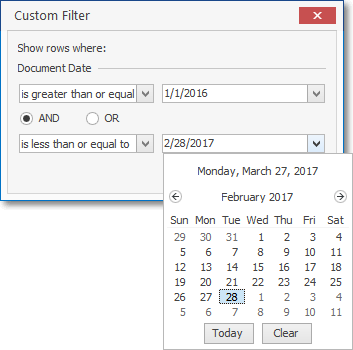
▪Using the first Drop-Down Selection List the User would choose the first "comparative" phrase from the list provided.
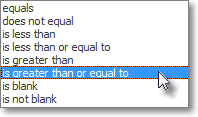
▪Then, the User would enter the value to be compared, and because the system knows it will be a Document's Date, it offers a Drop-Down Calendar/Date Entry field from which a Date may be chosen.
▪Next, the AND button is selected (by default) - but this may be changed, if appropriate; or ignored if no additional comparison is needed (e.g., any Document Dated after 01/01/2014 would be acceptable)
▪Assuming a comparison is needed (it wold be in this case), use the second Drop-Down Selection List to choose the other "comparative" phrase from the list provided.
▪Finally, the User would enter the other value to be compared, and because the system knows it too will be a Document's Date, it offers a Drop-Down Calendar/Date Entry field from which a Date may be chosen.

✓Click OK and the Custom Filter is implemented.
•When a Custom Filter is active, that Filter Criteria (the instructions for the filter) is displayed at the bottom of the Grid.
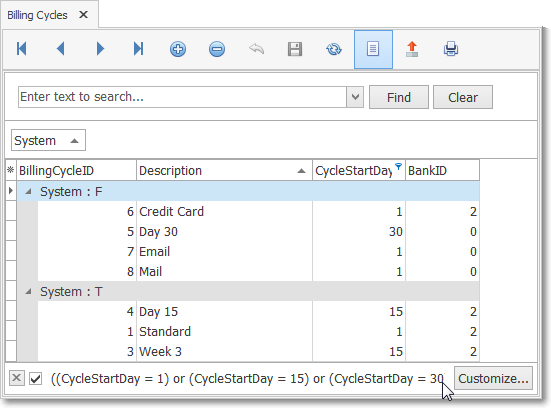
✓The User may Check and un-check the Filter Criteria to quickly see the differences in the data that is displayed when the filter is active, or inactive

✓To Cancel the Custom Filter, Click the Close box on the bottom left side of the Filter Criteria line.
•Enhancing the Custom Filter:
✓Once defined, a Custom Filter may be further refined or expanded by Clicking the "Customize..." button at the bottom right of the Grid (which only appears if a Custom Filter is active - see arrow in the illustration below).
✓The Filter Builder dialog will be displayed with the original Custom Filter information already inserted..
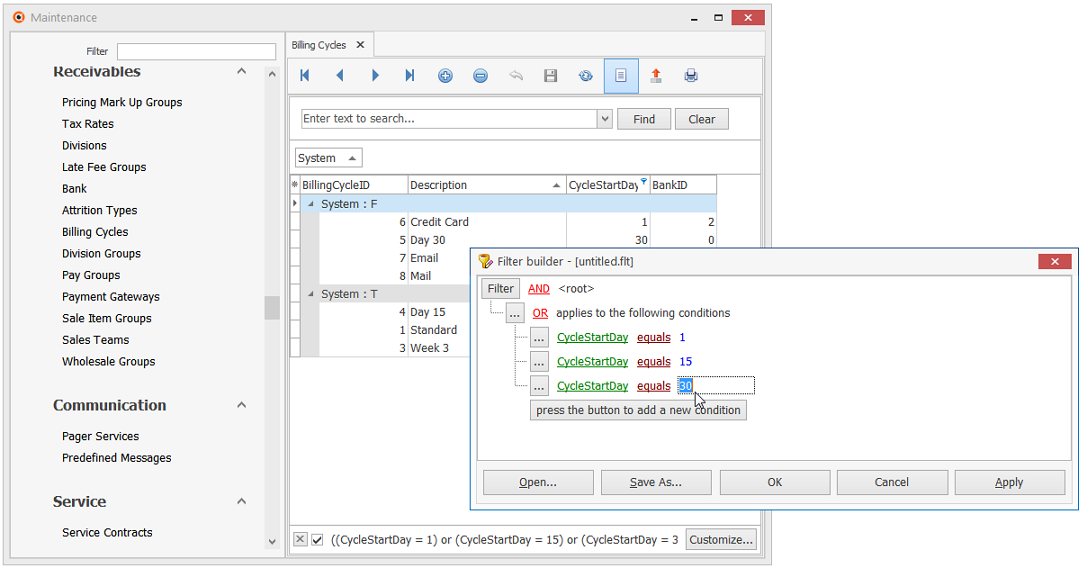
❑Understanding the Print Icon options:
•The Print option - offered when the Grid option is selected on the Navigation Menu of most General Maintenance Forms - does not have a predefined Report Format, but instead provides a tabular view of the records that can be rearranged, sorted, filtered, printed and exported.
•Before opening the Print Preview Form, use the Data Grid to properly position the Header Names (which can be relocated, as needed) and each column's width (which may be adjusted, as appropriate) so they are displayed on the Grid as they should be listed on the report
✓However, if any column does not fit or display properly, the Print Preview Form may be Closed to return to the Data Grid where those columns can be adjusted and/or repositioned to meet the needs of the report being defined.
✓Once reset, return to the Print Preview Form to finish the report's design.
✓Any user defined Print Preview enhancements (e.g., Headers, Footers, Page Numbering, Date & Time location, User Name, Machine Name) are stored and retrieved automatically for that User and for each Report that is derived from a Grid.
•See the Understanding the Print Preview chapter for more detailed information.
❑Understanding the Export Icon option:
•This Export option allows the User to create (one of there types of) a spreadsheet compatible file containing the Grid Data as it is currently organized and filtered (see Groups and Custom Filters above).
![]() Export - Click the Export Icon to display a standard Windows® Save As dialog
Export - Click the Export Icon to display a standard Windows® Save As dialog
▪The File Name may be specified (by default it is the Name of the Form from which the Export options was chosen).
▪The File Type may be specified (by default it is "XLS" but "TXT - Fixed Length", and "TXT Comma Delimited (CSV)" options are also available.